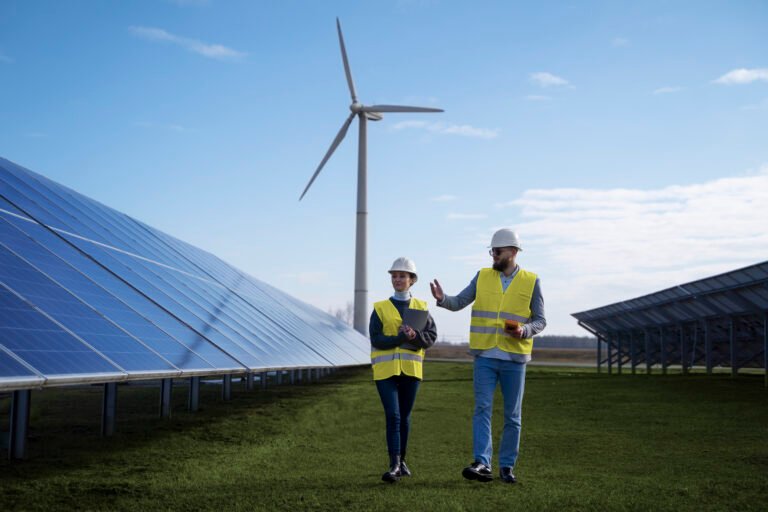
As the world faces climate change and rising energy demands, the shift toward emerging renewable energy technologies has become more crucial than ever. From wind energy and solar innovations to next-generation nuclear technology, the clean energy revolution is shaping a sustainable future.
In this article, we’ll explore the top 10 emerging renewable energy technologies that are redefining how we produce and consume energy globally. These breakthroughs are not just about reducing carbon emissions—they represent the future of clean energy and a path to a greener, more resilient planet.
- Floating Solar Farms: Expanding Solar Potential
Traditional solar panels require large tracts of land, but floating solar farms—installed on lakes, reservoirs, and oceans—are transforming how we harvest sunlight.
These systems increase efficiency due to water’s cooling effect and minimize land use conflicts. Countries like China and India are leading this sustainable innovation, making it one of the fastest-growing sustainable energy solutions.
- Offshore Wind Energy: Harnessing the Power of the Sea
Wind energy is one of the most established renewable sources, but offshore wind farms represent a major leap forward. Positioned in deep waters where winds are stronger and steadier, offshore turbines can generate far more power than land-based ones.
Innovations like floating wind platforms are allowing turbines to be installed in deeper waters, expanding access to untapped energy resources.
- Advanced Nuclear Technology: Small Modular Reactors (SMRs)
Modern nuclear technology is undergoing a green transformation. Small Modular Reactors (SMRs) are safer, more efficient, and produce minimal waste compared to traditional reactors.
Unlike large-scale nuclear plants, SMRs can be built faster and placed closer to where power is needed—making them an essential part of the future of clean energy.
- Green Hydrogen: The Fuel of Tomorrow
Hydrogen has long been seen as a potential clean fuel, but producing it without carbon emissions has been a challenge—until now. Green hydrogen, generated through electrolysis powered by renewable energy, is gaining momentum.
It can power vehicles, industries, and even entire cities, providing a sustainable energy solution that complements solar and wind.
- Next-Generation Solar Cells: Perovskite and Tandem Technology
Solar energy is becoming more efficient thanks to perovskite solar cells, which can capture a broader spectrum of sunlight.
Tandem solar cells, combining silicon and perovskite layers, are breaking efficiency records, potentially lowering the cost of solar power dramatically. This innovation represents a major leap in emerging renewable energy technologies.
- Geothermal Energy 2.0: Superhot Rock Innovations
Traditional geothermal plants depend on naturally occurring hot springs, but new drilling technologies now make it possible to access superhot rock energy deep within the Earth.
This form of sustainable energy solution can provide constant, carbon-free power anywhere in the world, reducing dependence on fossil fuels.
- Wave and Tidal Energy: Power from the Ocean’s Motion
The ocean holds vast, untapped potential. Wave and tidal energy systems convert the movement of water into electricity, offering a reliable and predictable source of renewable energy.
Unlike solar and wind, tidal energy is consistent, making it a key player in the future of clean energy for coastal nations.
- Bioenergy with Carbon Capture and Storage (BECCS)
Bioenergy uses organic materials like crop waste, wood, and algae to generate power. But with carbon capture and storage (CCS), it becomes even more sustainable by removing CO₂ from the atmosphere during energy production.
This technology provides both renewable power and negative emissions—an essential tool for fighting climate change.
- Energy Storage Breakthroughs: Solid-State Batteries
One of the main challenges in renewable energy is storing excess power efficiently. Solid-state batteries offer a safer, longer-lasting alternative to lithium-ion batteries.
They’re crucial for stabilizing solar and wind energy systems and enabling electric vehicles to travel farther with faster charging times.
- Artificial Photosynthesis: Mimicking Nature for Energy
Inspired by how plants convert sunlight into energy, artificial photosynthesis aims to produce fuels directly from sunlight, water, and carbon dioxide.
Still in the research stage, this innovation could revolutionize how we generate clean fuels—transforming sunlight into hydrogen or other usable energy sources.

The Impact of Emerging Renewable Energy Technologies
These emerging renewable energy technologies are more than just scientific breakthroughs—they are reshaping industries, economies, and lifestyles.
By combining innovation with environmental responsibility, the world is moving toward sustainable energy solutions that ensure long-term prosperity without compromising the planet’s health.
Governments and private sectors are increasingly investing in these innovations to achieve net-zero emissions targets and secure a cleaner, greener future.
Challenges Ahead
Despite rapid advancements, there are challenges to overcome—such as the high initial costs, infrastructure development, and global policy alignment.
However, with continuous innovation, supportive policies, and public awareness, these technologies will soon become mainstream drivers of the future of clean energy.
Conclusion
From floating solar farms to green hydrogen and advanced nuclear technology, the world’s energy landscape is transforming at an unprecedented pace. These emerging renewable energy technologies not only reduce our dependence on fossil fuels but also promise a cleaner, more resilient planet for generations to come.
The journey toward sustainable energy solutions is well underway—and the innovations listed above are lighting the path toward a brighter, greener future.
1. What are emerging renewable energy technologies?
Emerging renewable energy technologies are innovative methods of generating clean power—such as floating solar, green hydrogen, and advanced nuclear reactors—that aim to reduce carbon emissions and improve efficiency.
2. How does nuclear technology support the future of clean energy?
Modern nuclear technology, such as Small Modular Reactors, provides stable, low-carbon power, complementing intermittent sources like wind and solar energy.
3. Which renewable energy technology has the most potential?
Green hydrogen and advanced solar cells are among the most promising technologies due to their scalability and ability to integrate with other renewable systems.
